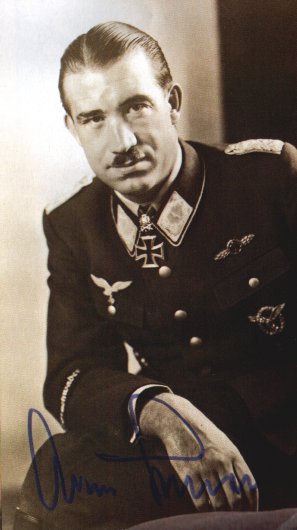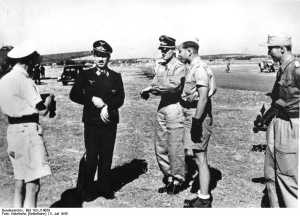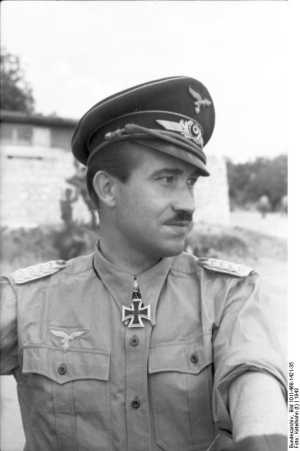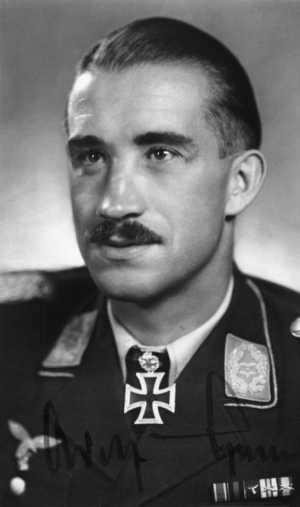Adolph Galland
Luftwaffe General of Fighters
By Stephen Sherman, Aug. 2002. Updated July 6, 2011.
Galland was the youngest general grade office of either side in World War II. He survived both the Spanish Civil War and World War II, and worked for Argentinian dictator Juan Peron.
A holder of the Knight's Cross with Oak Leaves, Swords and Diamonds, Galland died in 1996 at the age of 83.
Youth
Galland was born in Westerhold, a small village in Westphalia on March 19, 1912. He had three brothers: Fritz, Wilhelm, and Paul (the latter two also being Luftwaffe pilots.).
The youngest, Paul was shot down and killed in 1942, and Wilhelm a year later. Paul had 17 victories, and Wilhelm had 54 and the Knight's Cross. Galland started building model airplanes when he was 12 years old, and flew gliders at 16. He became a successful glider pilot, and hoped to become a commercial airline pilot.
In 1933, after one year of commercial pilot training, he was strongly "invited" to join Germany's clandestine air force. His training as a fighter pilot helped immensely with the commercial pilot's courses, but by 1937 he had "volunteered" for the Condor Legion, the German pilots who flew for General Franco's forces in the Spanish Civil War.
He crashed a Focke-Wulf Fw-44 biplane in 1935 while in training. Everyone thought he was dead, and he was in a coma for three days. He had serious skull fractures, a broken nose, which never looked the same again, and was partially blinded in the left eye from glass fragments (some of which stayed in his eye for the rest of his life). After his recovery, he still had to pass the physical, which his CO, Major Rheitel, a World War One pilot, "helped" him to pass. Galland continued flying, but a year later he crashed an Arado Ar-68 and again was hospitalized. The doctors pulled his file, which stated that he was grounded. To pass the next eye examination, he memorized every letter and number in every combination on the eye chart.
Spain
Galland traveled to Spain with the "Union Travel Society," a front organization for German fliers bound for Nationalist Spain. They disembarked at El Ferrol on May 7, 1937. In Galland's group there were many future aces, such as Hannes Trautloft, Wilhelm Balthasar, Günther Lützow, and Hajo Herrmann. Galland became a squadron leader in the Condor Legion Fighter Group, equipped with Heinkel He-51 biplanes. Lützow commanded a squadron of the new Messerschmitt Bf-109Bs.
The Condor Legion, commanded by Generalleutnant Hugo Sperrle, comprised four squadrons each of fighters and bombers, and a reconnaissance squadron, over 5,000 men in total.
In Galland's first engagement in Spain, at Brunete, July 1937, the Condor Legion sent every plane it had against the "Reds," who were equipped with modern Russian Polikarpov I-16 "Ratas." The Legion's air support and German artillery saved the day for Franco's Fascist forces. In Spain, Galland first displayed his dashing style - flying in swimming trunks, clenching a cigar between his teeth, flying an aircraft gaily decorated with a Mickey Mouse figure. But he was was no mere show-off; he flew over 300 missions in Spain, developed early gasoline bombs, and was awarded the Spanienkreuz mit Schwertern in Gold mit Brillanten (Spanish Cross with Swords in Gold with Diamonds - I love the grandiloquent titles of German medals - ed.)
In Spain, Galland met Werner Mölders, who would become the first man to shoot down 100 airplanes. After Spain, he and Mölders were appointed Wing Kommodores of the Luftwaffe's fledglng fighter force.
World War Two
When Germany attacked Poland in September, 1939, Galland flew dive bombing and ground attack missions, flying the Henschel Hs-123. He soon won the Iron Cross and was assigned to Jagdgeschwader 27 (JG.27), with which he flew in the Battle of France. In May, 1940, he scored his first of twelve kills in that campaign.
By the Battle of Britain, Galland was with JG.26, as Gruppenkommandeur of III/JG.26. In the intense aerial combat of late 1940, aerial victories, promotions, and decorations came rapidly:
- promotion to Major on July 18
- awarded Ritterkreuz (Knights Cross) on August 22
- Kommodore of JG.26
- the Oak Leaves on September 25
- his 50th kill on November 1
- Oberstleutnant (lieutenant colonel) in November
- Oberst (colonel) in December
Galland continued to fly Bf 109's through 1941. On the day that he scored his 70th victory, he himself was shot down, his parachute tangling with aerial and just opening in time. Galland describes it in The First and the Last:
After my seventieth kill I was grounded by strict orders. This did not matter at first, as I could not move about for some days. But as soon as I could walk on a stick, I got myself two new aircraft and started to fly and to do some gun testing. I took it for granted that the grounding order only applied to combat flying.
Without my knowledge my leading rigger, Unteroffizier Meyer, had fitted an additional armor plating inside the roof of the cockpit. It was done with good intentions but on closing the lid I received a wretched bump on the head. I swore at him, but I was to regret it a few minutes later, because on this July 2 this test flight turned out to be nearly my last flight in action. A bombing raid was in progress on Saint-Omer with a fighter escort. I flew with my entire wing against them. We reached a favorable position for attacking. I gave the order for the attack and I was the first to dive down through the English fighter escort on to the bombers. Flying in a shallow right bank I fired from a distance of about 200 yards right down to ramming distance at one of the Blenheims in the first iow of the. formation. Pieces of metal and other parts broke away from the fuselage and from the right engine. Then she went up in flames and smoke. The remnants of her were found later. I could not observe the crash, because I got into a hot fight with the escorting Spitfires. While I was chasing one, a second got me. Everything rattled inside my crate. My cockpit was shattered. But what is more, my head got it again. Warm blood was running down my face. I was afraid of a blackout. I must not lose consciousness! With a great effort I succeeded in shaking off my pursuer and landing safely. My aircraft was a bit shot up: a 2-cm. cannon shell had exploded on the new armor plating on top of the cockpit. At the hospital Dr. Heim had to sew me up again. Without the armor plating nothing would have remained of this indispensable part of my body. Unteroffizier Meyer got special leave and 100 marks. I valued my head that much.
Not long after this, Galland met the famed British pilot, Douglas 'Tin Legs' Bader, and even communicated to the British a request for new artificial legs for the great ace.
These were delivered, along with a load of bombs, to a German airbase, a combination that Galland found most unchivalrous.
Late in 1941, Ernst Udet, a top Luftwaffe general and WWI ace committed suicide. En route to Udet's funeral, Werner Mölders, the General der Jagdflieger ("general of fighters"), was killed in a plane crash, Göring gave the job to Galland, who was by then decorated with "the Swords" and "the Diamonds." (The Knight's Cross to the Iron Cross with Oak Leaves, Swords and Diamonds "Das Ritterkreuz zum Eisernen Kreuz mit Eichenlaub, Schwertern und Brillianten")
He organized the fighter cover for the battle cruisers Scharnhorst and Gneisenau and the heavy cruiser Prinz Eugen when they made their famous "Channel Dash" in early, 1942; the RAF never touched the ships. Late in that year, at age thirty, he was promoted to General Leutnant, the youngest general of that rank on either side in WWII.
In his role as General der Jagdflieger, he reported to Hermann Göring, with whom he clashed on many occasions. By that point, Göring was merely Hitler's sycophant, and never contradicted the Führer.
Me-262 Jet
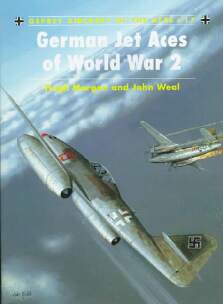
German Jet Aces of World War 2
(Osprey Aircraft of the Aces No 17),
by Hugh Morgan, John Weal
Galland test-flew Willy Messerschmitt's revolutionary new aircraft in 1943 (1942?), and pushed for its development as a fighter, while Hitler ordered that the jet be developed as a bomber. Its development as a bomber was delayed and its eventual use as a fighter was delayed over a year. While the Me-262 could fly more than 100 MPH faster than the Mustangs,its advent (late 1944) was too late. One of history's great "what ifs" is what might have happened if the Luftwaffe had had jet fighters from 1943. In a 1994 interview, Galland thoughtfully observed:
The Me-262 would most certainly not have changed the final outcome of the war, for we had already lost completely, but it would have probably delayed the end, since the Normandy invasion on June 6, 1944, would probably not have taken place, at least not successfully if the 262 had been operational. I certainly think that just 300 jets flown daily by the best fighter pilots would have had a major impact on the course of the air war. This would have, of course, prolonged the war, so perhaps Hitler's misuse of this aircraft was not such a bad thing after all.
In 1944, Galland oversaw the development of the world's first jet fighter group, the famous Kommando Nowotny. Led by the 255-kill Austrian ace Walter Nowotny from September 1944, this group demonstrated the jet's combat potential. Galland witnessed Nowotny's death on November, when Nowotny tried to land his damaged Me-262, but crashed and died in the explosion.
1945
In January, Galland, Günther Lützow, and other senior Luftwaffe fighter leaders met with Göring, aired their grievances, and recommended new policies (including Göring's resignation). Göring reacted to this challenge to his authority predictably, sacking all of the attendees, and threatening to have the lead spokesman, Lützow, shot. Galland was removed as General of Fighters, but, with Hitler's approval, formed his own Me-262 fighter unit.
Happy to be out of the political snakepit, and back in a fighter's cockpit, he created the Jagdverband 44 (JV.44) in March 1945. He recruited top Luftwaffe experten (aces), holders of the Knight's Cross or higher decorations, men like Johannes "Macky" Steinhoff, Gerd Barkhorn, Walter Krupinski, Heinz "Pritzel" Bär, Erich Hohagen, Günther Lützow, Wilhelm Herget. With the fast jets and armed with R4M rockets, JV.44 showed what could be done. Galland himself shot down two Martin B-26 Marauders with the rockets.
His last combat mission occurred on April 26, 1945, when JV.44 were attacking American bombers over Neuberg. Galland had scored some hits on a bomber when his 262 was hit; the instrument panel blew up and the canopy shattered. Injured in the knee, he dived down and managed to land, more or less intact. After that mission, Heinz Bär took over JV.44.
Post War
In the late 1940's, Galland, along with many other German aviation experts, went to Argentina to help Juan Perón build up and train his air force. He enjoyed his stay in Argentina, but in 1955 returned to Germany. For the next forty years he was a 'regular' on the aviation circuit, and won wide respect from his former opponents.
Sources:
The First and the Last by Adolph Galland. This book is a history of the air war over Europe from the German perspective, with a fair amount devoted to aircarft development, internal Luftwaffe problems, and such events as the Channel Dash. Even the Russian campaign and the American bombing strategy are surveyed. Relatively little on Galland's personal activities, dogfights, etc.1994 interview with Colin D. Heaton in World War II magazine
Fighter General: The Life of Adolf Galland, by Raymond Toliver and Trevor J. Constable.
The Luftwaffe Fighter Force: The View from the Cockpit, by Adolf Galland (Editor), Dave C. Isby (Editor)

